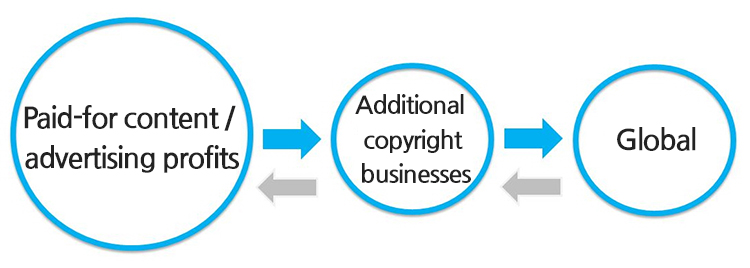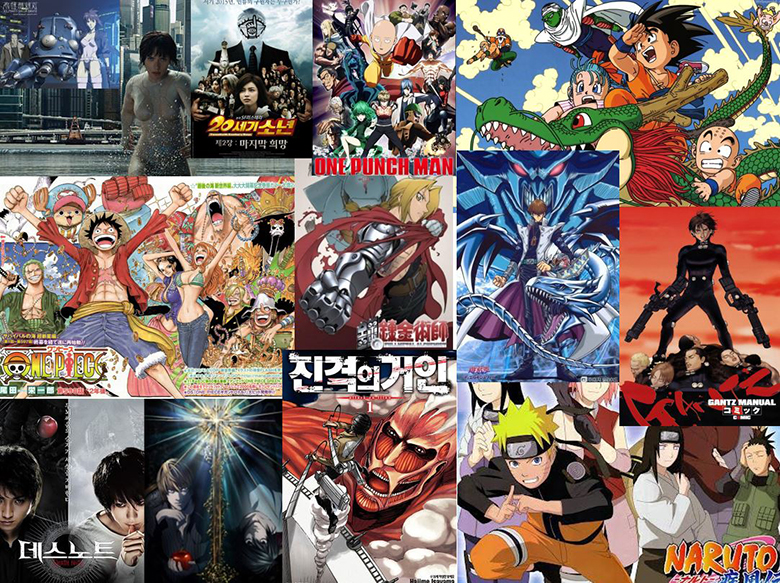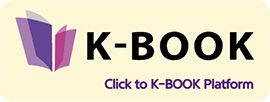|
The growth of K-Webtoons and strategy for global intellectual property
2018.01
The emerging of Lezhin Comics, a webtoon platform, in 2013 was an important catalyst in activating paid-for content markets in South Korea and also brought about the birth of a range of cartoon platforms. Previously the webtoon services on Internet portals like Naver and Daum were free of charge and gained many fans, expanding the market, but Lezhin Comics created their own success by handling genres difficult to address in public portals(adults only content) and seizing exclusive content. They also applied paid-for services strategies that can be seen in mobile and online games.
After, similar paid-for services for adults appeared and today, Kakao Page currently leads the paid-for cartoon market after having overcome its early losses by launching a 'wait for free content' service, where readers can wait a certain amount of time to access previously paid-for content. South Korea's webtoon market currently touts more than 20 platforms where more than 200 titles are uploaded every day.
△The more than 20 cartoon platforms in South Korea
Many of these platforms' first-stage profits come from paid-for content, but the return on investment in original content is low with the exception of certain genres(adult content, romance) or wildly popular works(comics that have been adapted into video form). As the number of platforms grows, the competition to find new talent has grown hotter and as a result, the gap between successful and not-so-successful platforms is also growing with time.
With the world's 27th-largest population and ranking 109th in territory size, South Korea's local consumption market has its limits. Realizing the limits of the paid-for content market in South Korea, platforms are already dabbling in other copyright businesses using intellectual property and or preparing to take their services overseas.
△ Profit structure of cartoon platforms
There are roughly 3,000 to 4,000 webtoons being serially uploaded every month but the number of works that have the competitiveness to garner success overseas is quite low. Part of this is due to the fact much of the content has been geared towards adult readers after 2013, but there is also a lack of know-how and information on planning and producing content that can reach a global audience.
Now is not the time to remain satisfied over the success from individual authors or sheer luck. It is critical for trans-media content planning and investment of a global nature take place inside a systematic and specialized system like studios. And companies should also be able to handle other copyright businesses involving television dramas, movies, games and character licensing at the same time.
There is also a need for analysis and selection of genres that have low culture discounts when it comes to selecting content elements. Having a low culture discount means one country's cultural goods can easily be accepted by other countries.
For instance, Japan is a country known for its manga and globally successful works so far include One Piece, Naruto, Dragonball, Attack on Titan, Death Note, Gantz and Ghost in the Shell. These are all fantasy themed works. Things of the imagination can all be shared by the world. Genres like fantasy, romance and fear/thrill have low cultural discounts.
△ Japanese manga that have low 'cultural discount' rates
Japan's manga still has great influence over the world in addition to Asia, but South Korea's comics have also managed to secure high spots when it comes to popularity or profits. It has competitiveness. However, South Korea does not have one major global hit and that is also a reality and limitation we need to come to terms with.
The smartphone environment we are living in today brought about the boom of the comic content market and with the debut of countless authors came about various sources of income. If for the past few years South Korea's comic market has developed in quantity, now would be the time for improvement in quality. It is an opportunity for systematic, specialized production studios to grow and progress together with platforms and authors to upgrade South Korea's global competitiveness in the comic market.
Written by Nam-yong Hwang (Head of Jaedam Media) Nam-yong Hwang (Head of Jaedam Media) |
Pre Megazine
-

Exports Trends of Korean Books in Japan
VOL.1
2017.06 -

Suzy Lee, a Picture Book Author who is popular abroad
VOL.1
2017.06 -

Trends in Korean Book Exports
VOL.2
2017.07 -

Bookpal
VOL.2
2017.07 -

South Korea Book Exports
VOL.3
2017.08 -

South Korea's 'Genre Literature'
VOL.3
2017.08 -

South Korea Book Exports
VOL.4
2017.09 -

Where Korean readers meet books (1)
VOL.4
2017.09 -

South Korea Book Exports
VOL.5
2017.10 -

Where Korean readers meet books(2)
VOL.5
2017.10 -

South Korea Book Exports
VOL.6
2017.11 -

Where Korean readers meet books (3)
VOL.6
2017.11 -

South Korea's Book Exports
VOL.7
2017.12 -

Setting South Korean Works on the World's Literary Stage
VOL.7
2017.12 -

Book exports by authors Sun-mi Hwang, You-jeong Jeong and Jung-myung Lee
VOL.8
2018.01 -

The growth of K-Webtoons and strategy for global intellectual property
VOL.8
2018.01 -

Exports to Southeast Asia
VOL.9
2018.05 -

A Society Easily Hurt: Readers In Search of Emotional Essays
VOL.9
2018.05 -

Poetry App “Siyoil”
VOL.10
2018.06 -

K-Thrillers lead Hallyu publications in Europe
VOL.10
2018.06 -

Books with Pictures ‘Uhwa Company’
VOL.11
2018.07 -

South Korean Literature, Expanding Its clout in Global Markets
VOL.11
2018.07










